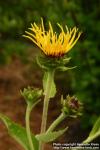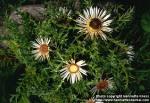
 "The root of Inula Helenium, Linné"—(U. S. P.) (Corvisartia Helenium, Mérat).
"The root of Inula Helenium, Linné"—(U. S. P.) (Corvisartia Helenium, Mérat).
Nat. Ord.—Compositae.
COMMON NAMES: Elecampane, Scabwort.
ILLUSTRATIONS: Millspaugh, Amer. Med. Plants, Pl. 81; Bentley and Trimen, Med. Plants, 150; Woodville, Med. Bot., 26.
Botanical Source.—Elecampane has a thick, tap-shaped, branching, aromatic, and perennial root, with a thick, leafy, round, furrowed, solid stem, from 4 to 6 feet high, branched and downy above. The leaves are large, ovate, serrate, veiny, smooth, of a dark-green color above, downy and hoary beneath, with a fleshy midrib; radical ones petiolated, from 1 to 3 feet in length, by 6 or 12 inches wide; cauline ones sessile and amplexicaul. The flower-heads are large, radiated, solitary at the downy summits of the branches, 2 inches broad, and of a bright-yellow color. The involucre is hemispherical; the outer scales broad, recurved, leafy, and finely downy on both sides; the inner ones linear. The florets of the ray are numerous, pistillate, long, and narrow, in 1 row, and terminate in 3 unequal teeth; the disk-florets are numerous, perfect, tubular, and 5-toothed, and the anthers have 2 bristles at the base. Ovary oblong. Achenia quadrangular and smooth; pappus simple and roughish. The receptacle is reticulated, and not quite smooth or naked (L.—W.—G.—T.).
History and Description.—Elecampane is common to Europe, and cultivated in this country, growing in pastures, along roadsides, etc., flowering from July to September. The root, which is the part used, should be gathered in the second year of its development, and during the fall months. When recent it is quite thick, spindle-shaped, dividing, with many delicate fibers; its color is yellowish-gray externally. Iodine colors the root brown, and the infusion is changed to a green color by the addition of ferric chloride. The U. S. P. describes Inula as follows: "In transverse, concave slices or longitudinal sections, with overlapping bark, externally wrinkled and brown; flexible in damp weather; when dry, breaking with a short fracture; internally grayish, fleshy, slightly radiate, and dotted with numerous shining, yellowish-brown resin-cells; free from starch; odor peculiar, aromatic; taste bitter and pungent"—(U. S. P.).
Chemical Composition.—The following percentage composition of inula is recorded in Hager's Handbuch der Pharm. Praxis, Vol. II, 1886, p. 76: "Inulin, 30 to 40; a trace of volatile oil; inula (alant) camphor, or helenin, a crystallizable, volatile substance, 0.5; wax, 0.3; acrid soft resin, 2; glutinous bitter extractive, 33; protein bodies, 12.5; cellulose, 9.6; potassium and calcium salts. Inulin (6C6H10O5.H2O, Kiliani, 1881), an isomer of starch, was discovered in elecampane by Val. Rose, in 1804, and was called by him alantin. Sometimes it is also termed helenin. It is a fine, white, starchy powder, very hygroscopic, tasteless, and inodorous; its specific gravity is 1.356. Iodine gives it a yellow color, which distinguishes it from starch, and also renders it insoluble in water. It is soluble in boiling water, from which it is deposited as the solution cools. It is insoluble in alcohol. Diluted acids, upon heating, transform it into laevulose, the intermediary products, metinulin and laevulin (C6H10O5), being formed. Ferments, e. g., diastase, yeast, emulsin, saliva, have but a slight sugar-forming effect upon inulin (Dragendorff, 1870; also see Husemann and Hilger, Pflanzenstoffe, 1882, Vol. I, p. 142). The researches of Kiliani made it probable that inulin is chemically the anhydride of laevulose (see Amer. Jour. Pharm., 1881, pp. 188 and 469). Its solution in boiling water produces left-handed rotation upon a ray of polarized light. It melts near 165° C. (229° F.), gives off water, and leaves a scaly, sweetish, gummy mass, readily soluble in water. Concentrated nitric acid, heated with it, converts it into oxalic acid. Diluted nitric acid, by oxidation, changes it into formic, oxalic, glycolic, and racemic acids. Inulin does not reduce Fehling's solution, nor does it undergo fermentation. It may be prepared in abundance also from dandelion roots, and those of the dahlia and other roots of the Compositae, when dug up in the autumn. Roots dug in the autumn yield over twice the amount (44 per cent, Dragendorff) yielded by spring roots. In the spring of the year a portion of the inulin seems to have been changed into laevulin, mucilage, sugar, and several glucosids.
Alant camphor (helenin) was observed in the root of elecampane as early as 1760, by Léfebure and others (see Husemann and Hilger), as it sometimes crystallizes on old roots. J. Kallen (Ber. d. Deutsch. Chem. Ges., 1873 and 1876), has shown this volatile substance, which be obtained by distillation of the root with water, to be composed of needle-like crystals of alantic anhydride (C15H20O2), melting at 66° C. (150.8° F.); alantol (C10H16O), an aromatic liquid; alant camphor proper (C10H16O), the latter a white substance melting at 64° C. (147.2° F.), of a mint-like, aromatic odor; and helenin (C6H8O), an odorless, bitterish, crystallizable principle, with melting point at 110° C. (230° F.).
Action, Medical Uses, and Dosage.—Elecampane is an aromatic stimulant and tonic, and is said to be expectorant, emmenagogue, diuretic, and diaphoretic. It is much used in chronic pulmonary affections, weakness of the digestive organs, hepatic torpor, atonic dyspepsia, with flatus, and internally and externally in tetter, itch, and other cutaneous diseases. When added to the compound syrup of spikenard, it should be exhausted by boiling alcohol, and the tincture added to the syrup, instead of boiling it with the other articles, as is usually done. The alcoholic extract, combined with powdered extract of liquorice, benzoic acid, sanguinaria, and morphine, forms a lozenge or pill very valuable in chronic catarrhal, bronchial, and all pulmonary irritations. One drop of the oil of stillingia may be added to each lozenge for bronchial and laryngeal affections. Night-sweats are relieved by inula, as are some cases of humid asthma, and, by its tonic properties, it tends to sustain the strength of the patient in chronic disorders of the respiratory tract. Helenin is accredited with a fatal action upon the tubercle bacillus by Korab, Blocq, and others. Inula is somewhat slow in action, and should be used for quite a time to get its full action. That it is an important remedy in irritation of the trachea and bronchiae is now well established. It is adapted to cases with free and abundant expectoration, teasing cough, and pain beneath the sternum, conditions frequent in la grippe, and the severer forms of colds.
An efficient preparation is that recommended by Prof. Locke (Syllab. of Mat. Med.): Rx Elecampane, ℥i; boiling water, 1 pint. Boil until but 8 ounces remain; add ½ pound of white sugar. Chronic vesical catarrh has yielded to the kindly action of elecampane. Both acute and chronic disorders may be treated with inula. It is also useful in leucorrhoea, and is especially effective in catarrhal endometritis, with discharge of glairy mucus. Dose of the powder, from 20 grains to 1 drachm; of the infusion, from 1 to 2 fluid ounces; syrup, 1 to 4 fluid drachms; specific inula, 5 to 40 drops; fluid extract, 10 to 60 drops; helenin, 1/12 to ¼ grain. Elecampane should be restudied in reference to its action in catarrhal affections of the respiratory organs, and especially in relation to the kind of cough which is mentioned above.
Specific Indications and Uses.—Cough, of a teasing, persistent character, accompanied with substernal pain, and profuse secretion; atony of abdominal viscera, with engorgement and relaxation; catarrhal discharges.
Related Species.—Inula squarrosa, Bernhardi (Inula Conyza, De Candolle; Conyza squarrosa, Linné). Herb used in Europe. Diuretic and emmenagogue, and, when charred, employed as an insecticide.
Pulicaria dysenterica, Gaertner (Inula dysenterica, Linné). Fleawort.—Properties like those of the preceding species.
 Carlina acaulis, Linné. Carline thistle.—Europe. The root, which is unpleasant in odor, and sweet, hot, and finally bitter to the taste, is the part employed. It contains volatile oil and resin. Diuretic and emmenagogue; large doses cathartic. The decoction or powder has been used in amenorrhoea, impotence, glossal paralysis, and in typhoid states of acute maladies. Dose of powdered root, from 10 to 20 grains, best administered in decoction. It appears to strongly influence the sexual organs of both male and female.
Carlina acaulis, Linné. Carline thistle.—Europe. The root, which is unpleasant in odor, and sweet, hot, and finally bitter to the taste, is the part employed. It contains volatile oil and resin. Diuretic and emmenagogue; large doses cathartic. The decoction or powder has been used in amenorrhoea, impotence, glossal paralysis, and in typhoid states of acute maladies. Dose of powdered root, from 10 to 20 grains, best administered in decoction. It appears to strongly influence the sexual organs of both male and female.

